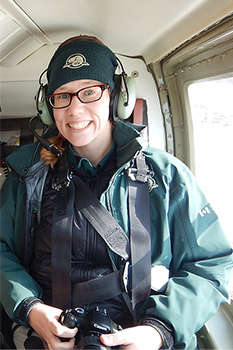Meet Christina Lawrence
Point Pelee National Park
Job Title

A/Resource Management Officer
What was your education/career path?
I wanted to be a park ranger ever since I spent a month camping and visiting national parks with my family when I was 13. I met people working in the parks we visited and I thought “I want to do what they are doing”. I attended college for forestry and then went to university for natural science and education. Prior to working at Point Pelee, I worked for Ontario Parks for 11 years presenting the natural and cultural heritage. I also tree planted and conducted tree pollination work.
What drew you to Point Pelee? When did you first start working at Point Pelee National Park?
When I lived in northwestern Ontario I would travel to Point Pelee every spring for camping and bird watching during spring migration. Long before I worked here I remember checking out the visitor centre displays and thinking “I want to work here!” It was somewhat random, or a twist of fate that I moved here when my husband started a new job in the area. Our first holiday season living in the area we took a picture of ourselves in front of the classic Point Pelee sign at the park entrance for our holiday cards. At the beginning I would say that even though I miss the wilderness of the north, Point Pelee is the best thing about moving to southern Ontario! Now I not only call the park home, but also work there (I started in 2013). The awesome thing about Point Pelee is that, due to its southern location, the field season is much longer compared to other parks in the country, extending the time we can complete field work outside, which I love doing.
What do you do for Parks Canada?
I work in the Resource Conservation department which I didn’t even know existed before I started working here. I do a lot of ecological monitoring in the park, I conduct surveys on the health of the plants and animals that live here. It is through surveys like this that we can monitor the changes in the animal and plant populations over time to determine their health. I have been involved with monitoring the breeding birding surveys in the park. It is pretty cool to say “I am going birding at work, for work!” The surveys involve being able to identify birds by sound/song and writing down all the species you hear. I also do a lot of work with monitoring and caring for Species at Risk trees.
Recently, I was involved with a project that conducted controlled pollination of red mulberry trees, which led to the propagation of tree seedlings, genetic testing of leaf samples and the improvement of habitat through invasive species removal, and finally, planting these rare tree seedlings in park. I also participate in other interesting jobs in the park like prescribed fire, field work on Middle Island, invasive species removal by canoe in the marsh, savannah restoration and protecting baby turtles.
What would you tell a young girl about working in science, technology, engineering and mathematics (STEM)?
Surprisingly, biology was not even my favourite subject in high school. So, don’t limit your career choice on which subject you are best at. Keep trying in the subjects that might challenge you. “Something you are good at” does not come “naturally”, it comes from spending a lot of time doing or practicing that skill. Education is important, but so is work experience. Have a good balance of both. Try different types of jobs in your chosen field of work. School can only expose you to so much. Go out into the world and try different types of work and experience everything. The internet has been great for opening up our exposure to different work and educational experiences that we might not have known about in the past. Don’t be afraid to take risks; whether it be moving for a new job, trying something you don’t like or going at it alone. Determination, hard work and persistence will help you achieve your goals.
- Date modified :